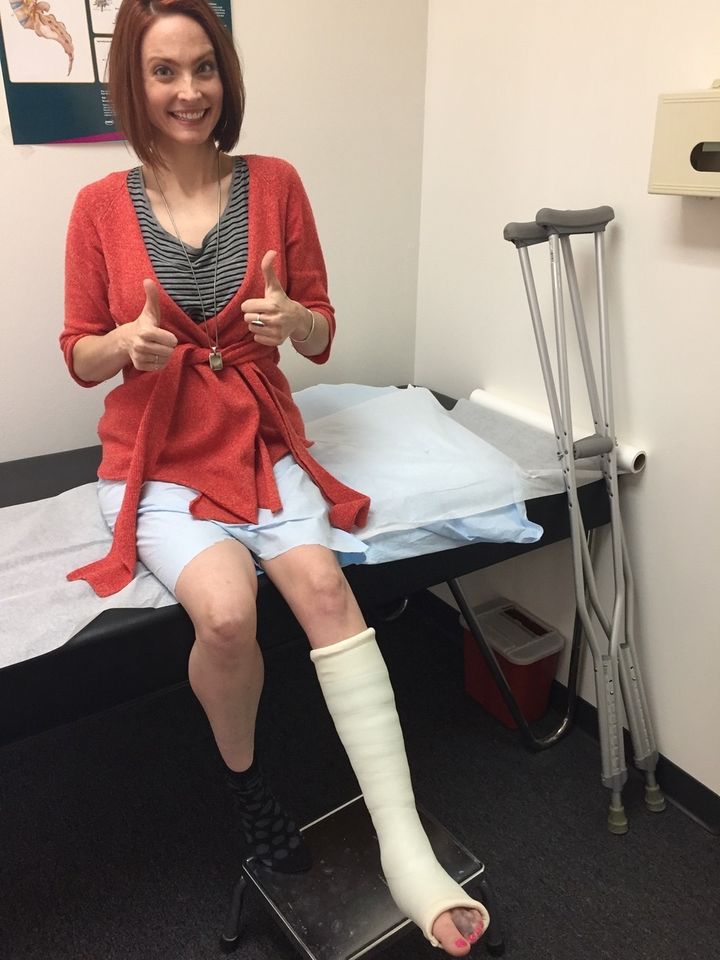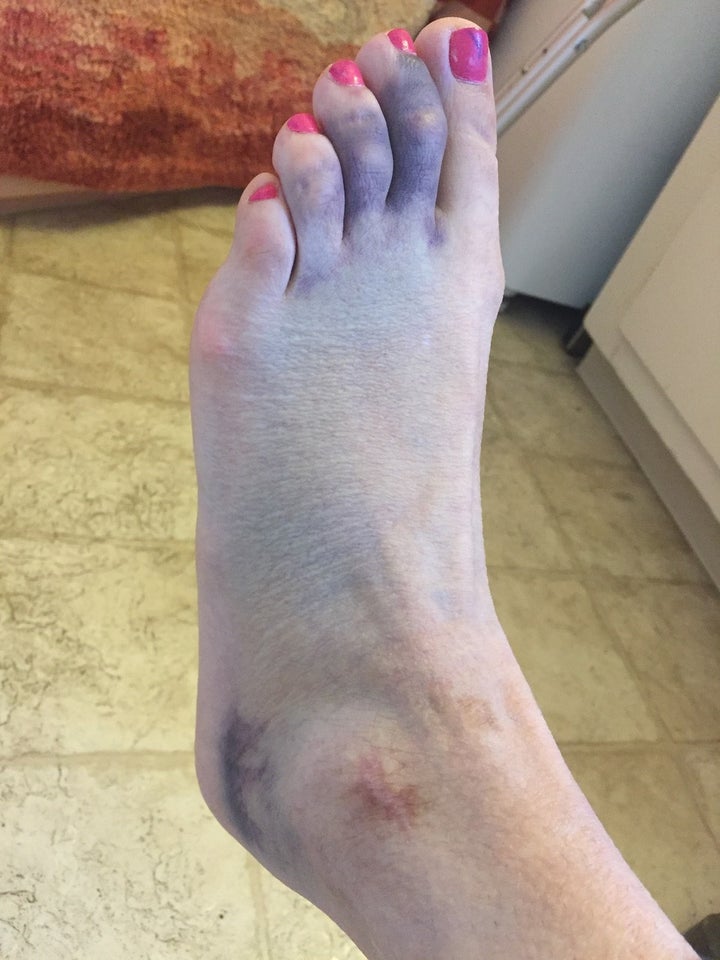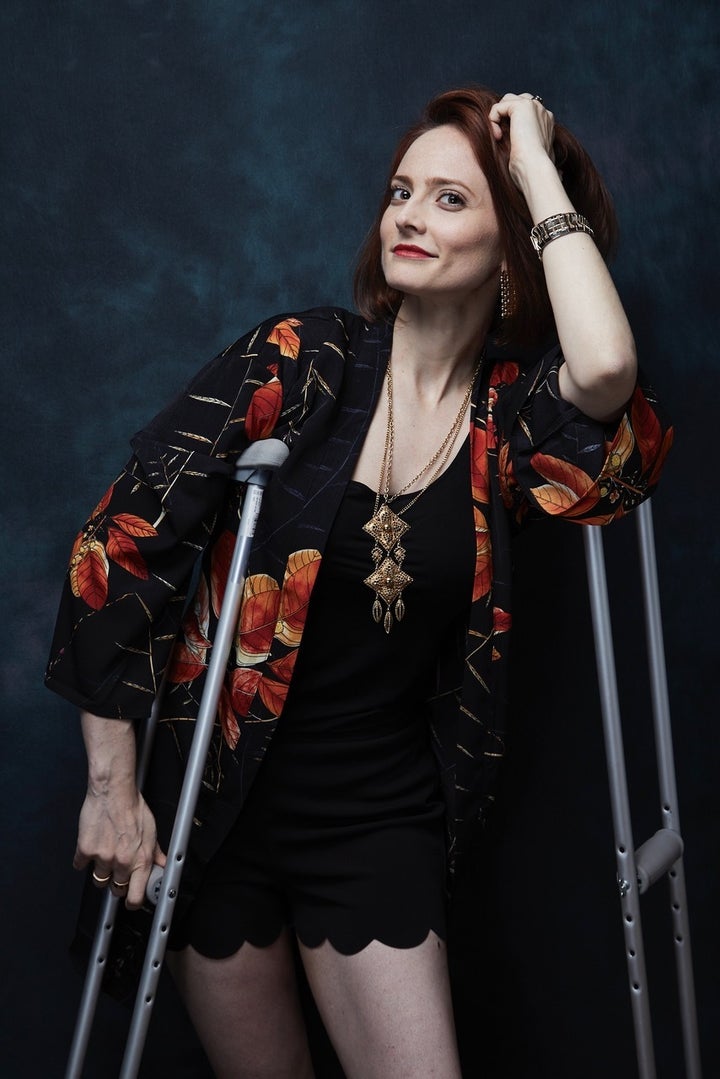
In 2003, just months after I’d graduated college, my dream of becoming an actor had come true. By day, I was rehearsing a world premiere musical at a new children’s theatre just west of Denver. By night, I performed in a contemporary drama at a small theatre downtown.
At curtain call one Friday evening, I stepped forward to take my bow and flashed the crowd a smile when POP! Blinding pain consumed the right side of my face. The actor next to me, an equal look of shock in her eyes, leaned in and whispered, “Are you all right? I heard that.” I hurt too much to respond.
I left the theatre to ice what I assumed was a pulled jaw muscle and put myself to bed, hoping to feel better in the morning. I didn’t.
Still, the show must go on. Despite a horrible migraine, I mumbled my way through Saturday’s performance, but by Sunday I couldn’t get out of bed. A week later, I’d lost 10 pounds and both my jobs. The ambient noise of the city ― the windows shut, the curtains closed ― was so loud I wanted to fling myself into traffic.
Eventually, an X-ray revealed that I’d dislocated the tiny disc between my top and bottom jaw. The diagnosing physician was flummoxed that I’d sustained an injury typical for a bar fight or a car accident while smiling. I was sent home with pain pills and a referral for a maxillofacial surgeon.
***
I am what other people call “accident-prone.” I broke my first bone at age 3. In first grade, I fractured a wrist leaning into a backbend. My gymnastics teacher, who’d been spotting my descent onto the foot-thick crash pad, dismissed my cries. The “Get Well Soon!” stuffed bunny she later sent was little consolation for the indignity of not being believed. As soon as that cast came off, a kid at school tripped me and I rebroke the wrist.
For as long as I can remember, my ankles have ached and snapped. “Growing pains,” the doctors assured my parents. Despite wearing expensive, not-covered-by-insurance custom orthotics inside uncool ’90s high-tops, my feet are, to this day, as flat as floorboards. At last count, I have had nine ankle breaks between the right and left. The first of six on the left happened while I was still in the second wrist cast.
At recess, I wanted nothing more than to play soccer, but I got hurt nearly every time I did. I broke two elbows in gym class, prompting accusations of attention-seeking from both kids and teachers. When it became clear it wasn’t safe for me to play like everyone else, I lost all unstructured social time with my peers, isolating me even further.
My clumsiness earned me other sobriquets as I grew up: Grace, Bubble Girl, Desert Rose. In honour of my constant cracks and pops, one boyfriend called me the Rice Krispie Queen. Another man I dated cited the state of my body as part of his concerns when he broke up with me. He wanted a family, and watching me climb the stairs to his apartment like it was Machu Picchu unnerved him.
“If you feel this bad now, how will you ever care for small children?”
At that point in my early 30s ― still in pain after having ankle and knee surgery, with hip surgery on the horizon ― I wondered the same thing myself. But the last thing I wanted was to be seen as frail, fragile or weak.
I didn’t want to be Laura Wingfield from “The Glass Menagerie.” I wanted to be Lara Croft from “Tomb Raider.” Or at least as much of her as I could be, given my breakability.

The second-most inexplicable break happened when I stood up from my desk and my ankle shattered beneath me. This event raised enough concern to prompt a biopsy, which was negative for cancer, which led to a scan that was negative for osteoporosis, which cued a rheumatologist who poked a few sensitive places, then asked, “Can you pull your thumb backward to your wrist?”
I obliged, touching my thumbnail to my radius. “I could really flatten it out when I was a kid,” I offered, almost apologetically.
“What about your hips?”
“They kill me.”
“Flexible, too?”
“I used to bet people I could put my leg behind my head for free drinks. Don’t think I spent a dime in all of 2006.”
That’s when she diagnosed me with hypermobile Ehlers-Danlos syndrome (hEDS). This rare connective-tissue disorder prevents my body from properly producing collagen, leaving my joints vulnerable to excessive movement, forcing my muscles to do the heavy lifting and causing chronic musculoskeletal pain. The flat feet, the migraines, the break-not-bend experiences, the “painsomnia” that keeps me up at night, even the mottled scaring on my face ― all symptoms of hEDS.
And like so many people living with hEDS and other disorders on this spectrum, I’d gone my entire life not knowing what was wrong but feeling like my injuries were more a result of my choices than my genetics. Now that I understood what was happening to me, I asked the rheumatologist, “What’s to be done?”
She just shook her head. “It’s a worthless diagnosis.”
***
The jaw surgeon said the disc would eventually return where it belonged, so I was left with alternative therapies to manage the pain. I visited a dentist who put a steady stream of lidocaine into my face, moving the needle around during excruciating 20-minute sessions. I tried massage, Rolfing, biofeedback. Slowly, I acclimated to my painfully limited life.
One day, while softly gnawing a piece of steamed broccoli, a horrific CRUNCH set me back months. On my knees in my parents’ breezeway, I begged a call centre employee to schedule an appointment and not make me wait in a noisy emergency room. I don’t remember who ordered the MRI, but I know when the tech tried to slide the spacer inside the quarter-inch gap I could make between my top and bottom teeth, he couldn’t. Still, he managed to capture the image, which explained why I could no longer open my mouth: I’d shattered the disc, and the pieces were embedded in the muscle wall of my face. I was scheduled for surgery immediately.
But even after surgery, I still felt awful. A secondary infection caused my eardrum to burst; I spent another week in bed on antibiotics. Western medicine had thrown up its hands. Desperate to regain my life, I even called an energy healer recommended by one of the theatre reviewers in town. I do not believe in the supernatural, yet I swear this healer reached inside my mouth and pulled everything back into place.
Had it come to this – abandoning rationalism for relief? It had, and I did.

I may be accident-prone, but I’m also a badass bitch. Two of my fingers were permanently deformed in a fall during the first five minutes of my first skiing lesson; I skied for six more hours. When I shattered my ankle, pressing into upward-facing dog in yoga, my foot got stuck in a Barbie-like point. Since I couldn’t stand on both feet, I finished the 90-minute class on my knees. I still believe that if I’d driven a standard instead of a manual, I’d have hopped from the mat to the car and taken myself to urgent care.
By all outward appearances, I’m fit and strong. I can haul ass on my trail bike, giving my jack-of-all-sports fiancé a run for his money. And because I don’t give up, even when I clearly should, I don’t look delicate. My flexibility is desirable and likely explains why I feel successful at activities like yoga and dance, both of which hold extension in high esteem.
But because nothing looks “wrong” with me, people ― including physicians ― do not recognise the signs or the suffering I experience. Research confirms that without validation and care from health professionals, people with hEDS report a lower health-related quality of life and more difficulty managing their symptoms.
Even I succumb to this fatalistic view. I didn’t even revisit my diagnosis until late last year when my father’s brothers, doctors both, had patients with medical histories similar to mine and diagnoses of hEDS. My uncles asked me if I’d ever been tested.
That’s when I realised the impact of the rheumatologist’s dismissal. Worse than not being believed was someone believing I hurt and offering no solution.
***
I received my diagnosis in 2018, 15 years after dislocating my jaw on stage and one year after the world of Ehlers-Danlos research changed the language describing this spectrum of disorders. Under this new categorisation, many more people ― somewhere between 1 in 600 and 1 in 900 ― were described as having hypermobility spectrum disorder (HSD) and hEDS, making my symptoms much more common than previously thought. In contrast, a much smaller population ― between 1 in 3,000 and 1 in 5,000 ― falls on the more rarified side of the 13 Ehlers-Danlos types.
Because of their collective status as rare diseases, experts argue that hEDS and HSD don’t get the attention they deserve, given the number of people affected. If more health care professionals knew what to look for, patients would receive earlier diagnoses; better, multi-disciplinary management of symptoms; and support to weather these lifelong conditions. My experience with my jaw would have been profoundly different if more people understood how hEDS presents instead of assuming I was just a klutz.
Medically speaking, there’s not much to be done ― no supplement to rebuild the collagen, no futuristic CRISPR solution. People with Ehlers-Danlos and HSD are advised to avoid contact sports and to do physical therapy to strengthen muscles and prevent injury.
I continue to practice yoga ― enough to keep me strong and allow me to stretch this very flexible and very tight body, but not so much that I fracture the facets in my vertebrae, as I have before. Though I love chewing gum and Bugs Bunny-sized carrots, I try to be delicate with my jaw. And much to the disappointment of my fiancé, I make very calculated decisions about the risks and rewards of any physical activity.
But until I truly accepted my diagnosis, nearly five years after receiving it, I still believed that if I just tried hard enough, I could somehow overcome whatever it was that kept pulling me down again and again and again.
These days, I’m learning to take a lot more personal time. If I have a migraine, I do not barrel through as I used to. As per doctor’s orders, I spend no more than two hours in heels, and if I don’t feel well ― and there are plenty of times I don’t ― the show no longer goes on.
This isn’t resignation; it’s self-compassion. It reminds me of a quote often attributed to J.M. Barry: “Be kinder than necessary because everyone you meet is fighting some kind of battle.” In this, I find reconnection where I was once cleaved. The invisible battle connects us all.